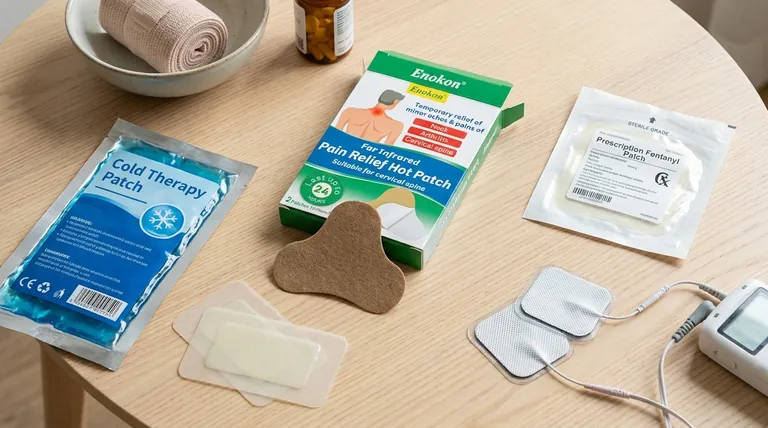Pain relief patches offer a convenient and targeted approach to managing various types of pain, from minor muscle aches to chronic conditions. They can be broadly categorized into prescription and over-the-counter (OTC) options, each with distinct mechanisms and applications. Prescription patches often contain potent medications like opioids or NSAIDs for severe or chronic pain, while OTC patches use milder ingredients like lidocaine or capsaicin for temporary relief. Other specialized types include hot/cold patches for thermal therapy and TENS machine patches for electrical stimulation. Choosing the right patch depends on factors like pain severity, underlying cause, and individual sensitivities, making consultation with a healthcare professional advisable for optimal results.

Key Points Explained:
-
Prescription Pain Relief Patches
- Contain potent medications like opioids (e.g., fentanyl) or NSAIDs (e.g., diclofenac).
- Used for chronic or severe pain, such as post-surgical recovery or cancer-related pain.
- Require medical supervision due to risks of systemic side effects or dependency.
- Example: pain relief patches with diclofenac combine pain relief and anti-inflammatory effects for conditions like arthritis or sprains.
-
Over-the-Counter (OTC) Patches
- Include milder analgesics like lidocaine (numbing agent) or capsaicin (derived from chili peppers).
- Ideal for temporary relief from muscle aches, joint pain, or minor injuries.
- Fewer side effects but may cause skin irritation in sensitive individuals.
-
Hot/Cold Therapy Patches
- Hot patches: Use heat to improve blood flow and relax muscles (e.g., for stiffness or cramps).
- Cold patches: Reduce inflammation and numb sharp pain (e.g., for acute injuries or swelling).
-
TENS Machine Patches
- Deliver low-voltage electrical impulses to block pain signals and stimulate endorphin release.
- Often used for chronic back pain or neuropathy.
-
Specialized Formulations
- Capsaicin patches: Target nerve pain (e.g., shingles or diabetic neuropathy) by depleting substance P, a pain-signaling chemical.
- Lidocaine patches: Numb localized areas, useful for post-herpetic neuralgia or minor cuts.
-
Considerations for Use
- Skin sensitivity: Adhesives or active ingredients may cause irritation; patch testing is recommended.
- Duration: Some provide 8–12 hours of relief, while others (like prescription patches) last days.
- Placement: Avoid broken skin or mucous membranes to prevent excessive absorption.
-
Alternatives to Patches
- Oral medications (NSAIDs, opioids) for systemic relief.
- Physical therapy or topical creams for non-patch options.
Pain relief patches are particularly effective for persistent, localized discomfort, offering discreet and sustained relief. However, their suitability depends on the pain’s origin and severity, emphasizing the need for personalized medical advice.
Summary Table:
| Type of Patch | Key Ingredients/Mechanism | Best For | Considerations |
|---|---|---|---|
| Prescription | Opioids (fentanyl), NSAIDs (diclofenac) | Chronic/severe pain (e.g., post-surgery) | Risk of side effects; medical supervision required |
| OTC (Lidocaine/Capsaicin) | Lidocaine (numbing), capsaicin (nerve pain) | Muscle aches, minor injuries | May irritate sensitive skin |
| Hot/Cold Therapy | Heat (blood flow) or cold (inflammation) | Stiffness, acute injuries | Avoid prolonged use on sensitive skin |
| TENS Machine Patches | Electrical stimulation | Chronic back pain, neuropathy | Requires TENS device |
| Specialized (Capsaicin) | Depletes substance P (nerve pain) | Shingles, diabetic neuropathy | Temporary burning sensation |
Need custom pain relief patches for your brand or distributors?
Enokon specializes in bulk manufacturing of transdermal patches and pain plasters tailored to your requirements. Benefit from our technical expertise in R&D to develop formulations for specific pain conditions (e.g., arthritis, neuropathy, or menstrual cramps). Contact us today to discuss your project and leverage our reliable, high-quality solutions!
Products You Might Be Looking For:
Shop heating patches for menstrual cramp relief
Visual Guide

Related Products
- Far Infrared Deep Heat Relief Patches Medicated Pain Relief Patches
- Capsaicin Chili Medicated Pain Relief Patches
- Menthol Gel Pain Relief Patch
- Icy Hot Menthol Medicine Pain Relief Patch
- Prostate Pain Kidney Health Care Patch for Men
People Also Ask
- How do pain relief patches provide targeted relief? Discover the Science Behind Effective Pain Management
- What are pain relief patches and how are they used? A Guide to Safe, Targeted Relief
- How often should pain relief patches be used? Get the Right Schedule for Targeted Relief
- How do pain relief patches compare to other pain relief methods? Discover Targeted, Long-Lasting Relief
- How do Deep Heat Pain Relief Patches provide pain relief? Discover the Drug-Free Mechanism
















